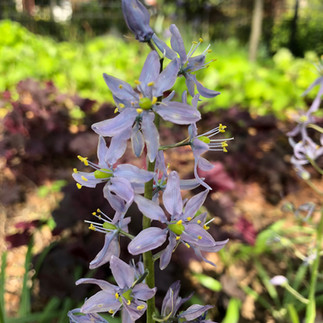Spring Bulbs: Wild Hyacinths
- Nuts for Natives
- Apr 27, 2022
- 2 min read
A perfect native alternative to ornamental bulbs.

Eastern wild hyacinths (Camassia scilloides) can substitute for ornamental bulbs such as grape hyacinths (Muscari armeniacum), Siberian squill (Scilla siberica) and Spanish bluebells (Hyacinthoides hispanica). Racemes of lavender flowers emerge atop 1 to 2 foot high stems in mid to late spring.
Growing
Wild hyacinths grow best in moist soils and full sun. They also grow just fine in dappled shade as these are and tolerate drier soils when not growing or blooming. These bulbs also grow in clay soils. Here, eastern wild hyacinths emerge in late March to early April and bloom in April. The sunnier the spot, the earlier they will bloom. They look terrific planted in groups.
It is important to leave the foliage to grow after the bulb has finished flowering. The foliage feeds the bulb before it goes dormant to give it the energy needed to flourish the following spring. Clumps of bulbs I have planted get larger each year. The eastern wild hyacinths shown above were planted 6 months ago so are not yet mature.
Wild hyacinths are perennial and will continue to flower year after year. Clumps will also gradually grow in size. The Missouri Botanical Garden advises not to disturb bulbs after they are planted to get the best growth. Wild hyacinths also make great cut flowers.
The United States has several native wild hyacinths. Eastern wild hyacinth (Camassia scilloides) has a lavender flower and is native to the eastern United States. Southern wild hyacinth (Camassia angusta) also has a lavender flower and is native to the central and southeastern U.S. Common camass (Camassia quamash), native to the west, has deeper blue colored flowers.

Sourcing
Should you search for camassia bulbs on-line, the bulbs for sale are typically the "quamash" type, those native to the northwest. Eastern camassia, the "scilloides" type, are much harder to find. If you do happen upon more than one source, it is advantageous to select older or larger bulbs if you are interested in getting mature blooms and plants quickly. Most will get as large as the bulbs at the left and center above. The bulb on the right is younger.
Prairie Moon Nursery currently has our native camassia bulbs for sale. The bulbs are four to five years old. The bulbs will be shipped after the plants go dormant. If you want to add eastern wild hyacinth to your garden, now is the time to purchase bulbs as they are not always available. (Nuts for Natives has no financial connection to any nursery or business -- just promoting native plants!)
If you have seen these natives in bloom, you may already be wild for wild hyacinths!

























Great post!